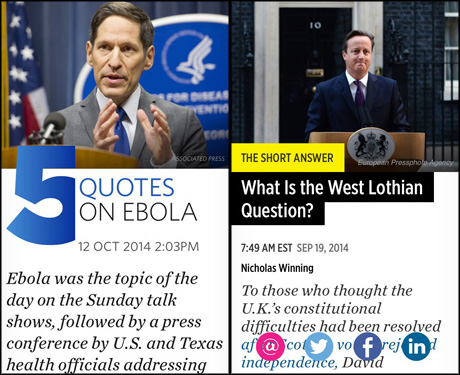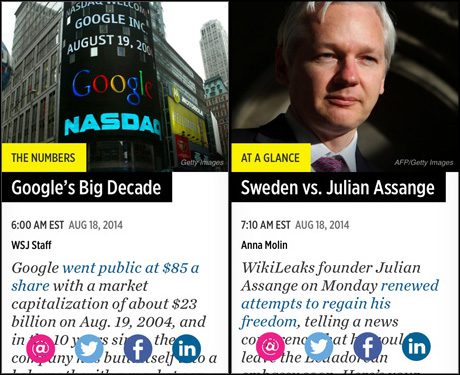There are also specific peaks to that traffic, often in the morning or at the weekend when people are more likely to be on the move or away from their desk.
"We need to think about how the content is packaged," said John Crowley, digital editor EMEA at The Journal, particularly when thinking about how people may be viewing work on mobile.. @mrjohncrowley shares mobile traffic growth to @WSJ #newsroom14 pic.twitter.com/O2xz3iDs8F
— Alastair Reid (@ajreid) October 14, 2014
Lead news editor for mobile Emily Banks developed a selection of article templates for a new "briefly" blog to meet this demand and find "visual ways to tell the story on mobile responsive formats" Crowley said.
All the blog content is outside the paywall and free to access, and Crowley shared the thinking behind the templates during a session on engaging new audiences at the International Newsroom Summit in Amsterdam today.
Five things
Using a list format to quickly relay information around a story has been successful on mobile at the Journal, Crowley said, so 'five things' gives readers the key facts or points of a story.

Screengrabs from wsj.com showing the '5 things' and 'Briefly' format
The short answer
For complex stories or topics, posting a Q&A "on a problem that can be answered quickly" is a good way to engage mobile readers, said Crowley.
When David Cameron mentioned 'the West Lothian question' in a statement to the press close to the Scottish referendum, "people were literally tweeting 'what is the West Lothian question?'" he said.
With the blog format the Journal could quickly answer that question, and "the piece went to the top of Google".
The numbers
Picking out pertinent figures also solves the issue of telling a story at speed and 'the numbers', another article template on The WSJ's 'Briefly' blogs, takes this approach.

Screengrabs from wsj.com showing 'the numbers' and 'at a glance' formats
At a glance
The 'at a glance' format "breaks down a complicated story into a 200-300 format", Crowley said, and is "a great way for readers to go in-depth on content" as a "short scannable summary of a news development.
Video
'The short answer' is also published as a video for some stories, led by senior producer Jason Bellini.
Careful attention is paid to making the video work on mobile, so quick animations are often created using Adobe After Effects, as shown on the video about missing Malaysian Airlines flight MH370, below.
Chat apps
At the BBC, app editor Trushar Barot has been leading recent experiments in using chat apps to reach new audiences.
Earlier this year, Barot spent six weeks in Delhi trialling WhatsApp and WeChat around the Indian elections, and more recently launched a news service on Line, a chat app popular in parts of Asia.
"Push alerts, from a chat app, are probably the most potent content delivery system in history," Barot said, sharing the lessons learned so far from the experiments.
"When you press send you can guarantee you'll reach 100 per cent of your subscriber base," he said, "probably within minutes, if not instantly, and that will pop up on their phone."
Unlike news alerts on the BBC's custom built app, WhatsApp allowed the BBC team to send audio, video, and images, as well as text and links.
Adding a bit of personality was also effective, he said, as "chat apps enable you to be more intimate with your audience".
The "most engaged with" piece of content on WhatsApp asked users to show how they felt about a story using emoji, as it was a more personal way of communicating and allowed users to quickly and easily show how they felt.
Finally, Grig Davidovitz, chief executive officer at RGB Media, argued that email newsletters are still an important part of engaging with new audiences and turning occasional, "accidental" visitors into regular readers.
"You need to create a permanent link between a user and the website," he said, as the average internet users visit thousands of sites in a year but less than ten "on purpose".
He urged delegates to promote their newsletter "aggressively" and think of it as a product, so it "reflects the identity of the site".
More information about some best practice for email newsletters is available in this Journalism.co.uk podcast.
Free daily newsletter
If you like our news and feature articles, you can sign up to receive our free daily (Mon-Fri) email newsletter (mobile friendly).









